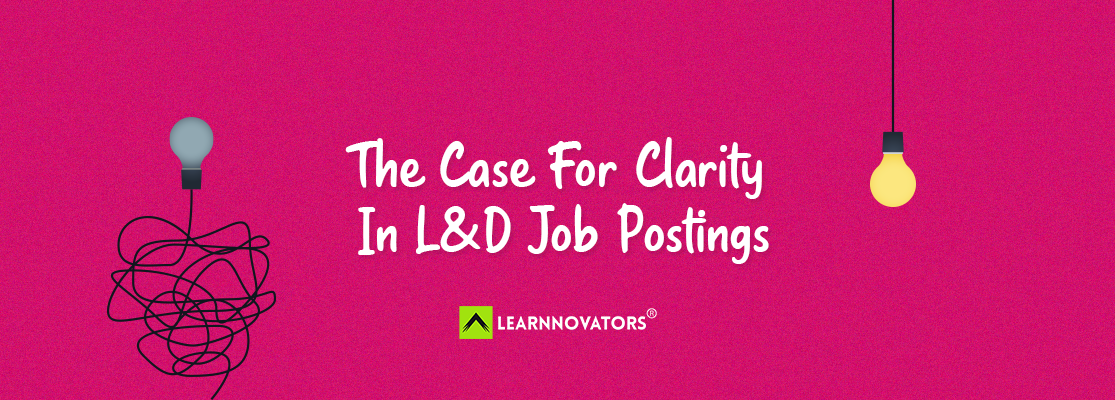Instructional design is a multifaceted field that requires a range of skills and expertise. There’s no denying that.
However, a recent job posting for an instructional designer that caught my attention read something on the lines of:
- Has the ability to create instructional materials that follow sound instructional design principles and learning theories.
- Demonstrates proficiency in learning and adapting to new software applications and technologies.
- Has an eye for spotting the best of resources on any given topic from a vast array of available information.
- Is proficient in using e-learning authoring tools like Articulate Storyline and Rise.
- Is comfortable using the latest graphic design and animation tools.
- Possesses knowledge and experience in data management and learning analytics.
- Has experience working with and administering a range of Learning Management Systems.
- Experience working with external partners and vendors would be an added bonus.
Contrast this with another job posting that read as follows:
- Work with leaders and experts to make effective training materials for classes, workshops, online learning, etc.
- Collaborate with the business to set clear learning goals that help the company achieve its objectives, and come up with ways to measure how well they work.
- Create fun, engaging, and easy-to-follow learning materials that use the latest research and design principles.
- Use your writing and teaching skills to explain complicated ideas in a way that anyone can understand.
- Keep track of all the materials in our system and make sure they’re organized and easy to find.
- Make a system for getting feedback on our training and then work on making it better.
- Teach classes when you need to and help other people do the same.
Both of these job postings call for instructional designers with a few years of experience. But do you notice the difference between the two?
The second job posting is focused on the skills and expertise of an instructional designer doing core design work, with a bit of analysis and consulting thrown in.
The first one, on the other hand, combines the jobs of an instructional designer, a curator, a graphic designer, an e-learning developer, a data analyst and an LMS administrator all rolled into one. Not to mention being a consultant to the business and being a leader and vendor manager too. Here’s the first posting again, with the key phrases highlighted:
- Has the ability to create instructional materials that follow sound instructional design principles and learning theories.
- Demonstrates proficiency in learning and adapting to new software applications and technologies.
- Has an eye for spotting the best of resources on any given topic from a vast array of available information.
- Is proficient in using e-learning authoring tools like Articulate Storyline and Rise.
- Is comfortable using the latest graphic design and animation tools.
- Possesses knowledge and experience in data management and learning analytics.
- Has experience working with and administering a range of Learning Management Systems.
- Experience working with external partners and vendors would be an added bonus.
This is not a one-off case. I keep seeing such jobs being posted regularly. Some even require project management and facilitation expertise in addition to a combination of the skills listed above.
I understand why companies do this. If an organization has a small L&D team, then it probably makes sense to want all team members to be proficient in all areas. However, the challenge is that by just seeing the job title, there is no way to guess what the role is going to entail.
One simple solution could be to specify whether the role is that of a generalist or a specialist directly in the job title. This approach is not new – other professions have been doing it for years.
Take HR for example. In the HR world, job titles often include words like “generalist” or “specialist” to make it clear what the position calls for. An HR Generalist is someone who handles a wide range of HR responsibilities, while a specialist typically focuses on one specific area of expertise, such as recruitment, benefits, or compensation. This way, job seekers know exactly what they’re applying for, and companies can attract the right candidates for the job.
Another example is the medical field. Doctors are generally either general practitioners or specialists. I could go on drawing examples from other industries and professions, but you get the idea.
In the L&D world, a generalist might handle a broad range of responsibilities, such as needs assessments, program design, and evaluation, while a specialist might focus on a particular area, such as e-learning development or instructional design. By including these terms in the job title, companies can avoid confusion and attract candidates with the right skills and experience.
Of course, not every L&D job fits neatly into a generalist or specialist category. Some roles may require a mix of both, or may have unique responsibilities that require a different job title altogether. But for those jobs where the distinction is clear, using the terms “Generalist” or “Specialist” in the job title can be a smart move.
In conclusion, by taking a page from other professions that use specific words in their job titles, L&D hiring managers can make their roles clearer and more attractive to the right candidates. So why not give it a try?
Your L&D team (and your future employees) will thank you.
Written by Srividya Kumar, Co-Founder @ Learnnovators






